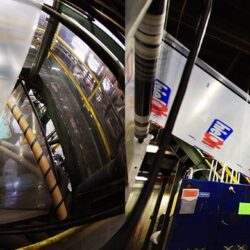Introduction
Structural steel shop drawings play a crucial role in the construction industry, acting as the blueprint that bridges the gap between architectural design and on-site execution. Structural steel shop drawings provide precise measurements, detailed fabrication instructions, and assembly sequences, ensuring that each steel component fits perfectly within the overall structure. By providing a clear visualization of complex connections, structural steel shop drawings minimize errors, reduce rework, and save both time and cost during construction. These drawings also guide fabricators, contractors, and engineers through the entire process, from cutting and welding steel members to their final installation. In projects ranging from high-rise buildings to industrial facilities, structural steel shop drawings ensure structural integrity and compliance with safety standards. Without accurate structural steel shop drawings, construction teams often encounter misalignments, fabrication delays, and cost overruns, making them indispensable for smooth project execution. The precision and clarity offered by these drawings make them a vital component of any construction endeavor that relies on steel as a primary material.
Understanding Structural Steel Shop Drawings
Structural steel shop drawings are specialized documents prepared by engineers or detailers that provide a comprehensive guide for fabricating and installing steel components. Unlike general construction drawings, which offer an overview of the project, shop drawings break down every steel member, showing dimensions, connections, weld specifications, and bolt placements. These drawings are developed after the completion of design drawings and serve as a bridge between theoretical design and practical application. By detailing exact sizes, cuts, and assembly instructions, structural steel shop drawings allow fabricators to produce components accurately and efficiently. They are particularly essential for projects with complex geometries, where precision is critical to ensure stability and safety.
The Process of Creating Structural Steel Shop Drawings
The creation of structural steel shop drawings begins with reviewing the design drawings provided by architects and structural engineers. Detailers then interpret these designs and convert them into precise fabrication plans using CAD software. Each steel member is measured, labeled, and illustrated with exact connection details, including bolt sizes, weld types, and orientation. After drafting, the drawings undergo thorough review by engineers to ensure compliance with design intent and safety codes. Any discrepancies or clashes are addressed before final approval. This meticulous process ensures that every piece of steel produced matches the required specifications, significantly reducing errors during installation.
Benefits of Using Structural Steel Shop Drawings
Structural steel shop drawings offer multiple advantages that contribute to efficient project execution. They provide accurate instructions for fabricators, reducing material wastage and labor costs. These drawings enhance communication among contractors, engineers, and construction teams, minimizing misunderstandings. Furthermore, they facilitate better project planning, as contractors can estimate timelines and resources more effectively based on the detailed drawings. By identifying potential design conflicts before fabrication, structural steel shop drawings prevent costly on-site modifications. Overall, their use ensures structural integrity, safety, and efficiency in every steel-based project.
The Role of Technology in Structural Steel Shop Drawings
Modern technology has transformed the preparation of structural steel shop drawings. Advanced CAD software and Building Information Modeling (BIM) tools allow detailers to create highly accurate and interactive drawings. These digital platforms enable real-time modifications, clash detection, and 3D visualization, which improve coordination across teams. Technology also allows for integration with fabrication machinery, ensuring that components are manufactured to exact specifications. By leveraging these tools, structural steel shop drawings have become more precise, efficient, and adaptable to complex architectural designs.
Common Challenges in Structural Steel Shop Drawings
Despite their benefits, creating structural steel shop drawings comes with challenges. One major issue is misinterpretation of design intent, which can lead to inaccuracies in fabrication. Coordination among multiple teams can also be difficult, especially in large-scale projects where various contractors and subcontractors are involved. Errors in dimensions or connection details can result in on-site delays and increased costs. Additionally, keeping the drawings updated with design revisions requires meticulous attention to detail. Addressing these challenges requires skilled detailers, advanced CAD tools, and a robust review process to maintain the accuracy and reliability of structural steel shop drawings.
How Structural Steel Shop Drawings Impact Construction Quality
The quality of a construction project is directly influenced by the accuracy of structural steel shop drawings. Precise drawings ensure that all steel components fit together seamlessly, supporting structural stability and safety. They reduce the likelihood of construction errors and the need for rework, leading to a smoother workflow and adherence to project timelines. Moreover, structural steel shop drawings help maintain compliance with building codes and engineering standards, protecting the project from potential legal and safety issues. By improving overall construction quality, these drawings play a pivotal role in delivering durable and aesthetically pleasing structures.
Choosing the Right Professionals for Structural Steel Shop Drawings
Selecting skilled professionals for creating structural steel shop drawings is critical. Experienced detailers and engineers with expertise in steel design can translate complex architectural plans into accurate fabrication instructions. Professionals who are proficient in CAD software and familiar with industry standards can deliver high-quality drawings that minimize errors and facilitate smooth project execution. Collaboration between detailers, engineers, and contractors ensures that structural steel shop drawings meet both design and practical requirements, ultimately contributing to a successful construction project.
The Future of Structural Steel Shop Drawings
The future of structural steel shop drawings is closely tied to advancements in digital technology and automation. The integration of 3D modeling, BIM, and AI-powered tools is expected to streamline the detailing process, reduce errors, and improve collaboration. Cloud-based platforms will enable real-time updates and remote access, allowing teams across different locations to work seamlessly. These innovations will enhance the accuracy, efficiency, and flexibility of structural steel shop drawings, further solidifying their importance in modern construction projects.
Conclusion
Structural steel shop drawings are an essential component of any steel-based construction project, providing detailed guidance for fabrication and installation. Their precision ensures structural stability, reduces errors, and enhances project efficiency. With the increasing reliance on digital tools, structural steel shop drawings are becoming more accurate and collaborative, setting new standards for construction quality. To maximize the benefits of these drawings, many firms are now seeking professional cad drawing services that combine technical expertise with advanced software capabilities. By leveraging cad drawing services, construction teams can ensure flawless execution, minimize delays, and achieve superior structural outcomes. Engaging experienced cad drawing services also helps in optimizing project planning, improving communication among teams, and maintaining compliance with engineering standards. In the rapidly evolving construction industry, cad drawing services are indispensable for translating design concepts into precise, actionable plans. Firms that utilize professional cad drawing services can expect enhanced productivity, reduced errors, and successful project completion, demonstrating why these services have become an integral part of modern structural engineering and construction workflows. By relying on trusted cad drawing services, companies can seamlessly bridge the gap between design and execution, ensuring every project meets its highest potential.




